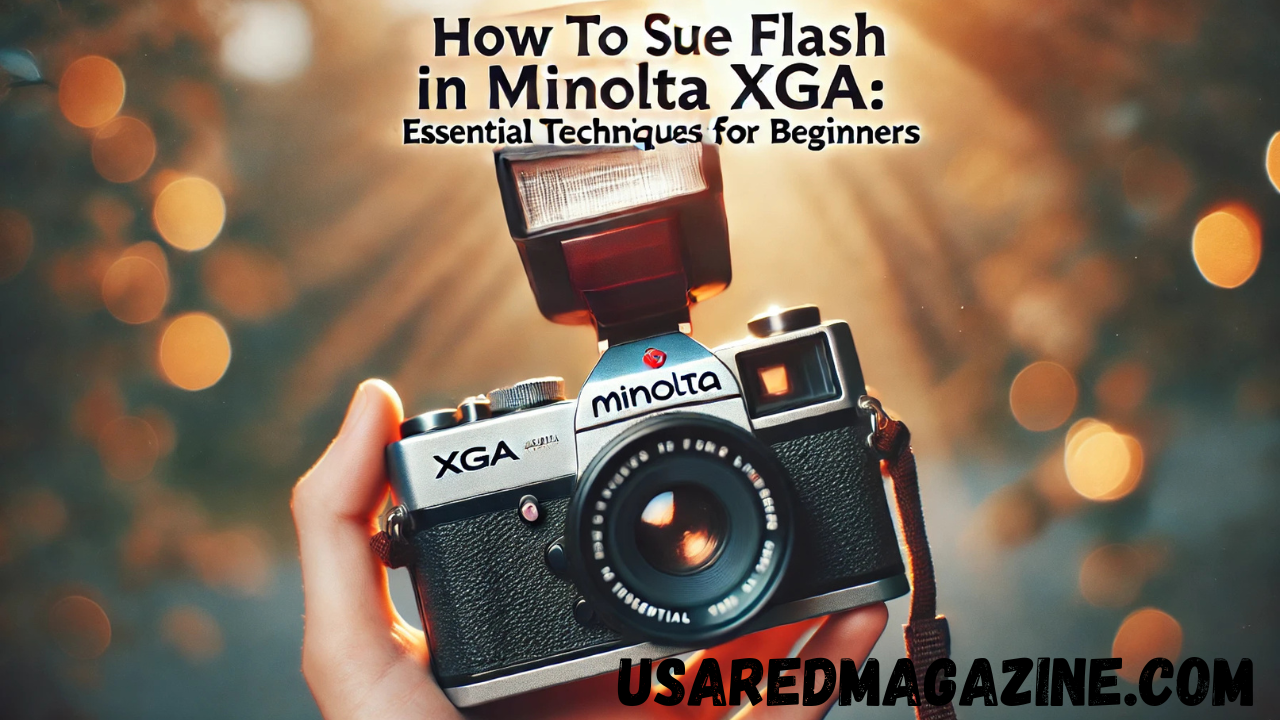Flash is one of the most crucial tools for your photography journey. The How to Sue Flash in Minolta XGA, well-regarded for its versatility and user-friendly features, allows photographers to harness flash power effectively. Understanding how to use How to Sue Flash in Minolta XGA can significantly elevate your photography, particularly in challenging lighting conditions. This comprehensive guide aims to provide you with essential techniques for using FlashFlash in Minolta XGA, enabling you to capture stunning photos regardless of the environment.
Understanding Flash Photography
Before diving into how to use How to Sue Flash in Minolta XGA, it’s essential to grasp the fundamentals of flash photography. Flash photography involves utilizing an artificial light source to illuminate a subject, enhancing visibility in dimly lit settings, or adding creative effects in well-lit scenarios. Flash’s primary purpose is to ensure your subject is adequately lit while reducing shadows and enhancing detail. Flash can transform a flat, lifeless photograph into a vibrant, dynamic image filled with depth and character when used correctly.
In the realm of photography, light is your most potent ally. How to Sue Flash in Minolta XGA provides various flash options, including built-in flash aFlashmpatibility with external flash units, offering photographers flexibility and creative control. Whether you are shooting indoors at a family gathering or outdoors during golden hour, knowing how to use FlashFlash effectively can make all the difference in achieving professional-looking results.
The Importance of Flash in Photography
You are utilizing FlashFlash cFlashhance in your photographic endeavors in numerous ways—one of the most significant advantages of employing flash flashover exposure. Natural light is often insufficient for optimal exposure, especially in low-light situations. Learning to use flash iFlasholta XGA compensates for this by providing a burst of light, ensuring your subject is well-lit, and reducing the likelihood of graininess in your images. Furthermore, flash cFlasheeze motion is beneficial in capturing fast-moving subjects, such as children playing or pets in action.
Flash also opens the door to creative effects that can elevate your photos from ordinary to extraordinary. Techniques such as backlighting, rim lighting, and dramatic shadows can all be achieved through the strategic use of Flash. Flashperimenting with different angles and intensities, you can develop your unique photographic style and produce captivating images that stand out.
Getting Started with How to Sue Flash in Minolta XGA
To effectively use Flash wFlashour Minolta XGA, it’s crucial to familiarize yourself with the camera’s settings and features. The Minolta XGA is designed with user-friendliness in mind, making it an excellent choice for beginners and seasoned photographers alike. The camera typically boasts a built-in flash that can automatically pop up when the lighting conditions dictate it, and various modes are used to optimize flash performance.
Key Flash Features of Minolta XGA
Understanding the flash capabilities of your How to Sue Flash in Minolta XGA will allow you to make informed decisions when shooting. The built-in Flash is convenient for everyday photography and is typically set to fire automatically in low-light situations. However, knowing how to control this Flash is essential to achieve the desired effect in your photographs. The Minolta XGA features different flash modes, such as Auto, Red-Eye Reduction, and Forced Flash, each catering to specific scenarios. Auto mode is ideal for beginners, as it adjusts the flash output based on the available ambient light. Red-eye reduction mode is designed to mitigate the common red-eye issue in portraits. At the same time, Forced Flash ensures that the flash fires regardless of the lighting conditions, making it helpful in filling shadows even on sunny days.
For those who seek greater flexibility and control, the Minolta XGA is also compatible with external flash units. These external flashes allow for advanced lighting techniques, providing the tools to create professional-quality images. Understanding how to use Flash eFlashively in Minolta XGA by utilizing these features is essential for any aspiring photographer.
Essential Techniques for Using Flash in Minolta XGA
Now that we have established the importance of flash photography and the features of the Minolta XGA let’s delve into some essential techniques that will help you maximize your flash usage and achieve stunning results.
Setting the Right Exposure
One of the most critical aspects of using Flash in Minolta XGA is getting the correct exposure. A well-exposed image is crucial to capturing the details and essence of your subject. To start, it is advisable to adjust your ISO settings. A higher ISO, typically between 400 and 800, will make your camera more sensitive to light, enabling the flash tFlashk more effectively in low-light conditions. Next, consider your aperture settings. A wider aperture, indicated by a lower f-number, will allow more light to enter the camera. This increased light intake works synergistically with the Flash, Facilitating a more balanced exposure.
When it comes to shutter speed, it’s crucial to keep it at or below your camera’s flash sync speed, which is usually around 1/200 to 1/250 seconds. Exceeding this speed can result in a phenomenon known as “flash banding,” where only a portion of the image is illuminated by the Flash, leading to undesirable results.
Choosing the Right Flash Mode
Using Flash iFlasholta XGA also involves choosing the correct flash mode tailored to different shooting situations. Understanding when to use each mode will help you achieve the best results.
- Auto Flash: This mode is ideal for beginners, as it automatically determines when the flash nFlashto fires based on the ambient light conditions. It is also perfect for general photography and ensures you capture great shots, even in tricky lighting.
- Red-Eye Reduction: The red-eye effect can be a common issue when photographing people, particularly in low light. Utilizing the Red-Eye Reduction mode will help minimize this effect by emitting a series of pre-flashes before the central flash fires. This pre-flash causes the subject’s pupils to constrict, reducing the chances of red-eye.
- Forced Flash: In situations where there is ample natural light, using Forced Flash can help illuminate your subject and fill in shadows. This is particularly useful when shooting in bright conditions where the sun may backlight your subject.
Familiarizing yourself with these modes and knowing when to employ them will significantly enhance your ability to capture stunning images with your Minolta XGA.
Flash Positioning and Angle
The positioning and angle of your Flash significantly influence the quality of your photographs. It is essential to experiment with different angles to see how they affect your subject’s lighting.
- Direct Flash: While pointing the Flash directly at your subject is common, it can create harsh lighting and unflattering shadows. Direct Flash is suited for controlled environments where you can manage the lighting effectively.
- Bounce Flash: Consider bouncing the Flash on the oFlashceiling or wall for softer, more diffused light. This technique spreads the light over a larger area, creating a more natural and pleasing look. When bouncing the Flash, Flashndful of the color of the surfaces you are bouncing off; for instance, a white ceiling will reflect neutral light, while a colored wall may cast a tint on your subject.
- Diffusers and Reflectors: Diffusers can further soften the light emitted from your Flash, Flashing harsh highlights and shadows. Reflectors can also help bounce light back onto your subject, ensuring a more balanced exposure. Both tools are simple yet effective ways to enhance your flash photography.
Using Flash for Portrait Photography
When exploring how to use Flash iFlasholta XGA, portrait photography is where flash techniques genuinely shine. Flash can create captivating, dynamic portraits that draw attention to your subject’s features.
- Fill Flash: When shooting in bright sunlight, using fill flash can prevent harsh shadows on your subject’s face. This technique helps to illuminate your subject evenly and creates a more flattering image.
- Rembrandt Lighting: Named after the famous painter, this lighting technique involves positioning the Flash at a 5-degree angle to your subject. This creates a classic portrait look, where one side of the face is well-lit while the other side features soft shadows, adding depth and dimension to the image.
- Catchlights: Catchlights refer to the reflections of light in a subject’s eyes, which can add life and vibrancy to a portrait. Aim the Flash flashly above your subject’s eye level to create catchlights. This positioning ensures that the flash flashes just the right amount of illumination to create those engaging reflections.
Experimenting with Flash Exposure Compensation
Flash exposure compensation is a powerful tool for adjusting the intensity of your flash output. Mastering this feature is essential for achieving perfectly exposed images.
- Increase Flash Output: If your images consistently appear too dark, consider increasing the flash output. This adjustment will help brighten your subject, particularly in low-light or backlit scenarios.
- Decrease Flash Output: If your images are too bright or harsh, decreasing the output can help achieve a more balanced look. This adjustment is handy when ambient light is sufficient, and you want to avoid overexposing your subject.
Creative Flash Techniques
Once you have a solid grasp of how to use FlashFlash iFlasholta XGA, don’t hesitate to explore creative flash techniques that can elevate your photography.
- Slow Sync Flash: This technique combines a slow shutter speed with a flash, allowing ambient light to blend seamlessly with the Flash. Flash is perfect for night scenes or capturing motion while maintaining detail in the background. For example, if you photograph a subject in front of a city skyline at dusk, a slow sync flash will illuminate your subject while capturing the beautiful ambient light of the skyline.
- Rear-Curtain Sync: In this mode, the flash fires at the end of the exposure, resulting in a trailing light effect. This technique is particularly effective for capturing movement, as it allows the subject to leave a light trail behind them, creating a dynamic sense of motion in the image.
- Multiple Flash Units: For those with access to various flash units, experimenting with off-camera flash setups can produce professional-quality photos. You can create intricate lighting patterns highlighting features and textures by positioning multiple flashes around your subject.
Common Flash Photography Mistakes to Avoid
Even experienced photographers can fall victim to common pitfalls when using Flash. Being aware of these mistakes can help you achieve better results.
- Not Adjusting Flash Exposure: Failing to adjust the flash exposure compensation can lead to either too bright or too dark images. Always review your exposure settings before taking the shot.
- Using Direct Flash Too Often: Relying solely on direct Flash reduces harsh shadows and an unflattering look. Instead, experiment with bouncing and diffusing light to create a more pleasing result.
- Ignoring Background Lighting: Paying attention to the ambient light in your environment is essential. Balancing Flash wFlashvailable light can create a more natural feel and enhance the overall composition of your photograph.
- Forgetting to Clean Your Flash Unit: Dust and grime can impact flash performance. Regularly clean your flash and camera equipment to ensure optimal functioning and consistent results.
Troubleshooting Flash Issues
At times, you may encounter problems when using Flash. Flashs how to troubleshoot some common issues:
- Flash Doesn’t Fire: If your flash flashes to fire, check that it is charged and correctly mounted on the camera. Additionally, ensure that the flash settings are correctly configured.
- Overexposed Images: If your images consistently come out overexposed, consider adjusting the flash exposure compensation and using a diffuser to soften the light.
- Red Eye in Portraits: To combat red eye in portraits, use the red-eye reduction mode or have subjects look slightly away from the camera when the flash fires.
Conclusion
How to Sue Flash in Minolta XGA can significantly enhance your skills and elevate your images. You can create stunning photographs in various conditions by understanding the fundamentals of flash settings, exposure, and positioning. Remember to experiment with different techniques, and don’t hesitate to adjust as needed. With practice and creativity, you’ll soon be able to capture beautiful, well-lit photos that stand out.
FAQs
1. What is the best flash mode to use in Minolta XGA?
The best flash mode often depends on the shooting situation. The Auto Flash mode is recommended for beginners, as it automatically adjusts based on the lighting conditions.
2. How do I prevent red-eye when using Flash iFlashMinolta XGA?
To prevent red-eye, use your camera’s Red-Eye Reduction mode. You can also try having your subjects look slightly away from the camera when the flash fires.
3. Can I use an external flash with my Minolta XGA?
Yes, the Minolta XGA is compatible with external flash units, allowing you more flexibility and control over your lighting setup.
4. What settings should I use for low-light photography with Flash?
Flashow-light photography, set a higher ISO (400-800), use a wider aperture (lower f-number), and ensure your shutter speed is at or below the camera’s flash sync speed (around 1/200 to 1/250 seconds).
5. How can I create soft lighting with Flash flash photographs?
To create soft lighting, try bouncing the Flash on the oFlashceiling or wall, using a diffuser, or adjusting the flash output to reduce intensity. Experimenting with these techniques will help you achieve a more natural look.
You May Also Read: https://usaredmagazine.com/onemt-vs-lokka-entertainment/




